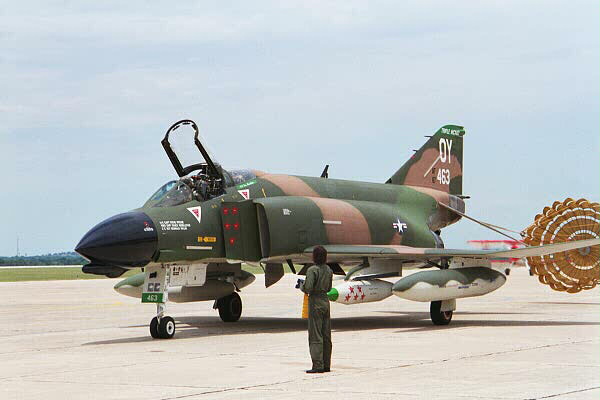|

The Collings Foundation's F-4D, NX749CF,
performs at Randolph
AFB, Texas, USA.
Photo by Buck Wyndham.
History:
The
F-4 is one of the most famous fighter aircraft of the post-World War II era, having been
used in large numbers by the air forces of many western nations, where it gradually
evolved in capability and mission diversity. First flown on 27 May 1958, the Phantom was
developed as a private venture by McDonnell and was first ordered by the US Navy as a
carrier-based attack aircraft (the F-4B).
Soon after its introduction to active service in December 1960, a fly-off competition was
conducted between the Phantom and various frontline Air Force fighters. The Phantom
excelled in the competition in such a decisive way that the US Air Force ordered a
slightly different version of the aircraft (the F-4C) and the
Phantom went on to equip over three-quarters of the USAF's fighter wings.
US involvement in the war in Vietnam saw the F-4
utilized in an increasingly multi-role capacity, delivering bombs in huge multi-aircraft
formations, shooting down North Vietnamese MiGs, and earning its rightful place in
history. Improvements in the aircraft's electronic systems, engines and airframe resulted
in many variants, including the F-4E (with more powerful
engines, leading-edge wing slats to improve maneuverability, and a 20-mm cannon); the RF-4E
(export version designed for tactical reconnaissance); the F-4F
(air superiority version for the German Luftwaffe, with air-to-ground weapons
system removed); the F-4G ("Wild Weasel" anti-missile
version); and the F-4K/M (Royal Navy/Royal Air Force versions,
respectively).
The latest variant, and certainly the last, are the QF-4N
pilotless target drones operated by the 82nd Aerial Targets Squadron at
Tyndall AFB, Florida. In addition to several others performing civilian-contract test work at
Mojave, California, a sole privately operated F-4 was made airworthy in the 1990s in the
USA, thanks to the hard work of both the USAF and the Collings Foundation. This F-4 is
occasionally still flown at airshows around the USA. (See photo above.)
Another F-4 is rumored to be close to airworthy condition in California.
The F-4 remains in service in several nations around the
world, including Japan, Greece, Turkey, Iran, South Korea, and Egypt.
Nicknames: Double Ugly; Rhino; Old
Smokey; Lead Sled; Elephant; St. Louis Slugger; Eisenschwein ("Iron
Pig"), Fliegender Ziegelstein ("Flying Brick"),
Luftverteidigungsdiesel ("Air Defense Diesel) (Luftwaffe nicknames); Tomb (early RAF nickname); Kurnass
(Israeli nickname meaning "Hammer")
Specifications (F-4E):
Engines: Two 17,900-pound thrust afterburning General Electric J79-GE-17 turbojets
Weight: Empty 29,535 lbs., Max
Takeoff 61,651 lbs.
Wing Span: 38ft. 5in.
Length: 63ft. 0in.
Height: 16ft. 6in.
Performance:
Maximum Speed:
1,485 mph (Mach 2.25) at 40,000 ft.
Ceiling: 62,250
ft.
Range: 1,100
miles
Armament:
One 20-mm M61A1
rotary cannon;
Four AIM-7
Sparrow missiles or 3,020 pounds of weapons under fuselage;
Up to 12,980
pounds of various weapons on underwing pylons.
Number Built: 5,195
Number Still Airworthy: One in civilian
hands;
Recent active service in the USA, Germany, Japan, Greece, Turkey and South Korea.
Links:
The Collings
Foundation's F-4D / (Additional site)
F-4 Phantom II Society
F-4 Phantom Site (UK)
German Air Force Flying Training Center --
Home of some of the last military F-4s in the USA, at Holloman Air Force Base, New Mexico.
Michel Klaver's F-4 Site -- Many, many
great photos and links.
Phantom's Phabulous
Phortieth
Phantom Phlyers -- (Text in German)
UGA Media's F-4 Phantom Reference
CD-ROM

[Back to Warbird Alley's Main
Page]
All text and photos Copyright 2016 The
Doublestar Group, unless otherwise noted.
You may use this page for your own, non-commercial reference purposes only.

|